We select the video card for miniITX-system
Somehow, I was faced with the question of buying a gaming set-top box for my children, but after some hesitation I decided to put together a gaming computer as large as these set-top boxes - i.e. miniITX format. Firstly, games are cheaper for PC games, secondly, you can play games for the game console that are not intended for PCs and which will never be released on consoles. In addition, I wanted the machine to combine the functions of a media server. Well, i.e. Children and play toys to play, and cartoons / movies to watch.
In accordance with this, I need a platform with a separate modern processor like Core i3 / i5 and a modern discrete video card. The rest (hard drive, Wi-Fi adapter, remotes, joysticks, optical drive) to taste. No sooner said than done.
But as it turned out, not everything is so simple. The last time I climbed with a screwdriver into the system unit about seven years ago and somehow I’m not very familiar with modern “iron” formats and technologies. As it turned out, assembling a miniITX computer turned out to be a nontrivial task with its pitfalls. Looking ahead, I will say that I had to buy / change previously purchased components, work with a hacksaw and a file, and as a result I assembled two mini-systems - a game machine for children and a workstation for myself.
It is considered that the lot of miniITX-systems is HTPC and workstations that are undemanding of the graphic subsystem. Indeed, the assembly of a gaming machine causes some difficulties associated with placing a video card in the case and an optimal cooling system.
')
Every fool knows that it is necessary to begin with a nutshell. Astrid Lindgren
There are several types of chassis for miniITX boards:
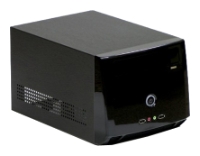
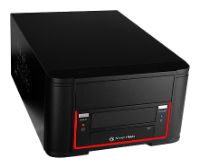
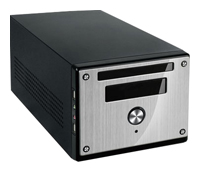
Width is 20-30 cm, length is 32-36 cm, height is 12-20 cm.
Perhaps the perfect case for our task. As a rule, in such cases a full-fledged ATX power supply unit with all the consequences is installed - active PFC, high efficiency, it can be replaced, the benefit of the offers on the market is enough. In such cases, you can install a full-sized video card and, as a result, a more powerful relatively low-profile one. In such cases, there are enough vents and it is possible to install a large low-speed fan inside, which has a beneficial effect on cooling during quiet operation. You can also install more than one hard disk.
The only minus is the size, or rather the thickness. Such a case can be installed only in one position and cannot be placed on a monitor / TV or hung on a VESA mount. But on it you can put a cup of coffee and a saucer with cookies.
Photos of the Codegen SuperPower MX31-A1 package

Actually, everything that I wrote about above is present in it.
Pay attention to the space for the video card. The video card should not just be single-slot, but should occupy exactly one slot. Most cards, though, are single-slot in reality due to the radiator and the fan occupy more space. You can find either the corresponding case, for example, the more expensive Cooler Master Elite 120 , or an appropriate video card, for example, one of these:


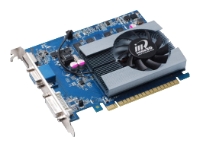
ZOTAC GeForce GT 640 900Mhz PCI-E 3.0 2048Mb 1066Mhz 128 bit, XFX Radeon HD 7750 800Mhz PCI-E 3.0 1024Mb 4500Mhz 128 bit, InnoVISION GeForce GT 630 810Mhz PCI-E 2.0 1024Mb 3200Mhz 128 bit, respectively.
The developers of these video cards require the installation of a power supply of 400 watts, which is quite realizable in the Barebone form factor form factor.

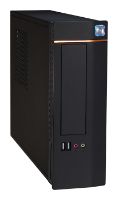
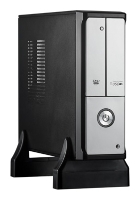
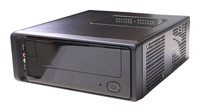
Width is 20-30 cm, length is 32-36 cm, height is 9-12 cm.
In size coincide with Barebone, only slightly thinner. This format already imposes some restrictions on us. Only low-profile video cards can be installed. Power supply units here are usually TFX size 8cmH8cmH15cm or Flex size 8cmH6cmX15cm with lower power than ATX (usually no more than 300 watts). The advantages include smaller than Barebone size and the ability to install both horizontally and vertically (usually included are the legs for horizontal installation). With horizontal installation, you can’t put a cup of coffee, as the ventilation holes will be blocked.
Case photos IN WIN BP659

Immediately visible problems with cooling. The power supply fan blows into the case, and the vent hole on the opposite side is blocked by a video card. The case fan only cools the hard drive. Vertical installation is possible only on the legs, otherwise the ventilation hole for the video card will be blocked. Be prepared for the fact that the case will be heated under loads.
There are also power supply cases in which is located not above, but below, and the video card is located directly above it. For example Foxconn RS-224 .
Also, some inconvenience may cause the use of the drive when the chassis is installed vertically. In some cases it is possible to install a slim-drive (Winsis Wi-08)
We also narrow the range of suitable video cards. The video card should be low-profile and occupy one slot. Compared to full-sized such video cards are less powerful.

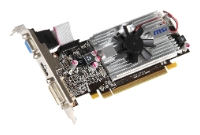
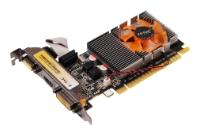
Point of View GeForce GT 630 810Mhz PCI-E 2.0 1024Mb 1066Mhz 128 bit, MSI Radeon HD 6570 650Mhz PCI-E 2.1 1024Mb 1800Mhz 128 bit, ZOTAC GeForce GT 610 810Mhz PCI-E 2.0 1024Mb 1066Mhz 64 bit.
Manufacturers of these video cards require a power supply of 300 watts, which can already cause some difficulties, because the power supply of 300 watts is the exception rather than the rule for this particular package format. In fact, even if the power supply will work with an efficiency of 70% (~ 200 watts) this power will be enough for normal machine operation:
Those. 150 watts is obtained as a maximum, and 90 watts at a minimum. Thus, it is quite possible to use the power supply of 160-200 watts.
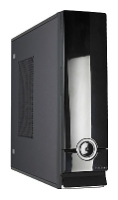


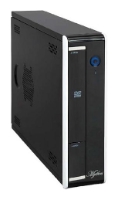
Width is 20-30 cm, length is 20-34 cm, height is 6-8 cm.
Cases of this type are smaller and lower than the previous ones. First of all, due to the fact that their main purpose is HTPC based on integrated CPUs and GPUs and workstations / thin clients. Such cases can be hung on a VESA mount on the monitor. These enclosures are not designed to use expansion cards (video cards) and picoPSU with a capacity of up to 90 watts act as a power supply. But there are instances with ATX-blocks with a capacity of 150-250 watts. As a rule, such power supplies have their own format and in the event of its failure it will be necessary to completely change the case. Due to the small size of the power supply units (~ 7cmH7cmH10cm), there is no need to talk about any voltage stabilization and high efficiency.
LinkWorld LC-920-03B hull photo
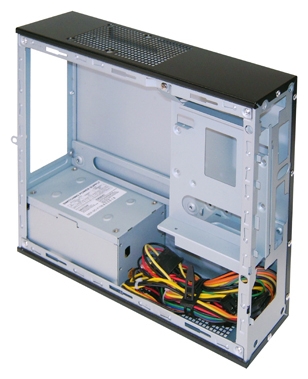
Given the small size of the case, the cooling system looks very good. The air flow from the power supply does not pass through the body, and blown down. Due to the upper and lower holes when the fans are installed in them, the housing will be blown very well. There is only a small problem with cooling the hard disk. The processor requires a low-profile cooling system.
Since a video card cannot be installed in any way, you will have to resort to the services of a hacksaw and a file, and we will also need additional tools. With proper skill, the video card can be placed parallel to the motherboard through a flexible or angled riser.
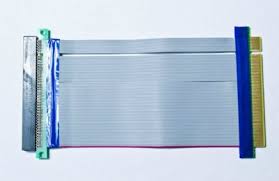

To implement such an idea, you will need to select a motherboard with the top location of the processor socket.
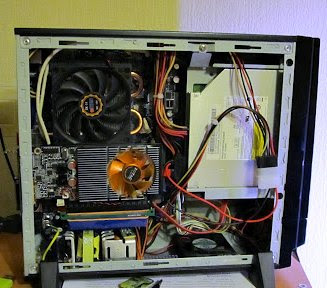
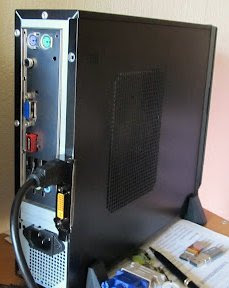
Unfortunately, with this approach, the video card overlaps the radiator of the south bridge, which complicates its cooling. When using a hard angle riser, the video card can be positioned below the motherboard by moving the power supply unit to the right. If this succeeds and the power of the power supply allows, then you can plug in a more powerful video card that takes up more than one slot. In the presented layout, only the compact ZOTAC GeForce GT 610 810Mhz PCI-E 2.0 1024Mb 1066Mhz 64 bit card will appear (photo above).
If you really want, you can
The graphics subsystem of modern Intel and AMD processors copes well with most modern games at low and medium settings in 720p resolution. You can also pay attention to motherboards with integrated discrete graphics card. At the moment, she is the only one - ZOTAC Z68ITX-BE with a discrete integrated NVIDIA GeForce GT 430 graphics processor for the LGA1155 processor. Intel Ivy Bridge support is available after flashing the BIOS.
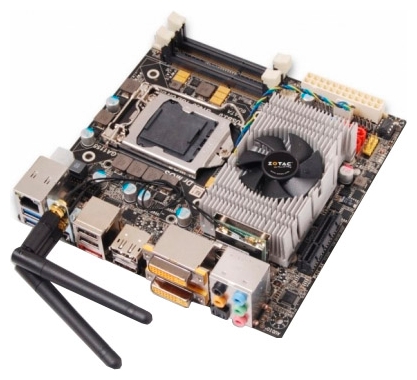
Performance and picture quality in modern games are quite subjective characteristics. Someone feels comfortable with the minimum settings and screen resolution, someone accepts only the highest quality and performance. Of course, the solutions presented here are very much inferior to powerful gaming machines, but each of them is quite efficient for its conditions.
PS Used photos from Yandex.Market
In accordance with this, I need a platform with a separate modern processor like Core i3 / i5 and a modern discrete video card. The rest (hard drive, Wi-Fi adapter, remotes, joysticks, optical drive) to taste. No sooner said than done.
But as it turned out, not everything is so simple. The last time I climbed with a screwdriver into the system unit about seven years ago and somehow I’m not very familiar with modern “iron” formats and technologies. As it turned out, assembling a miniITX computer turned out to be a nontrivial task with its pitfalls. Looking ahead, I will say that I had to buy / change previously purchased components, work with a hacksaw and a file, and as a result I assembled two mini-systems - a game machine for children and a workstation for myself.
It is considered that the lot of miniITX-systems is HTPC and workstations that are undemanding of the graphic subsystem. Indeed, the assembly of a gaming machine causes some difficulties associated with placing a video card in the case and an optimal cooling system.
')
Every fool knows that it is necessary to begin with a nutshell. Astrid Lindgren
Choosing a body
There are several types of chassis for miniITX boards:
- Barebone (it's square like that)
- Slim (thin cases with a thickness of 9-10 cm with the ability to install a low-profile video card)
- UltraSlim (thin cases up to 7 cm thick without the possibility of installing expansion cards)
Barebone



Width is 20-30 cm, length is 32-36 cm, height is 12-20 cm.
Perhaps the perfect case for our task. As a rule, in such cases a full-fledged ATX power supply unit with all the consequences is installed - active PFC, high efficiency, it can be replaced, the benefit of the offers on the market is enough. In such cases, you can install a full-sized video card and, as a result, a more powerful relatively low-profile one. In such cases, there are enough vents and it is possible to install a large low-speed fan inside, which has a beneficial effect on cooling during quiet operation. You can also install more than one hard disk.
The only minus is the size, or rather the thickness. Such a case can be installed only in one position and cannot be placed on a monitor / TV or hung on a VESA mount. But on it you can put a cup of coffee and a saucer with cookies.
Look inside
Photos of the Codegen SuperPower MX31-A1 package

Actually, everything that I wrote about above is present in it.
Choosing a graphics card
Pay attention to the space for the video card. The video card should not just be single-slot, but should occupy exactly one slot. Most cards, though, are single-slot in reality due to the radiator and the fan occupy more space. You can find either the corresponding case, for example, the more expensive Cooler Master Elite 120 , or an appropriate video card, for example, one of these:



ZOTAC GeForce GT 640 900Mhz PCI-E 3.0 2048Mb 1066Mhz 128 bit, XFX Radeon HD 7750 800Mhz PCI-E 3.0 1024Mb 4500Mhz 128 bit, InnoVISION GeForce GT 630 810Mhz PCI-E 2.0 1024Mb 3200Mhz 128 bit, respectively.
The developers of these video cards require the installation of a power supply of 400 watts, which is quite realizable in the Barebone form factor form factor.
Slim-Desktop format enclosures




Width is 20-30 cm, length is 32-36 cm, height is 9-12 cm.
In size coincide with Barebone, only slightly thinner. This format already imposes some restrictions on us. Only low-profile video cards can be installed. Power supply units here are usually TFX size 8cmH8cmH15cm or Flex size 8cmH6cmX15cm with lower power than ATX (usually no more than 300 watts). The advantages include smaller than Barebone size and the ability to install both horizontally and vertically (usually included are the legs for horizontal installation). With horizontal installation, you can’t put a cup of coffee, as the ventilation holes will be blocked.
What's inside
Case photos IN WIN BP659

Immediately visible problems with cooling. The power supply fan blows into the case, and the vent hole on the opposite side is blocked by a video card. The case fan only cools the hard drive. Vertical installation is possible only on the legs, otherwise the ventilation hole for the video card will be blocked. Be prepared for the fact that the case will be heated under loads.
There are also power supply cases in which is located not above, but below, and the video card is located directly above it. For example Foxconn RS-224 .
Also, some inconvenience may cause the use of the drive when the chassis is installed vertically. In some cases it is possible to install a slim-drive (Winsis Wi-08)

Choosing a graphics card
We also narrow the range of suitable video cards. The video card should be low-profile and occupy one slot. Compared to full-sized such video cards are less powerful.



Point of View GeForce GT 630 810Mhz PCI-E 2.0 1024Mb 1066Mhz 128 bit, MSI Radeon HD 6570 650Mhz PCI-E 2.1 1024Mb 1800Mhz 128 bit, ZOTAC GeForce GT 610 810Mhz PCI-E 2.0 1024Mb 1066Mhz 64 bit.
Manufacturers of these video cards require a power supply of 300 watts, which can already cause some difficulties, because the power supply of 300 watts is the exception rather than the rule for this particular package format. In fact
- Intel Sandy Bridge processors consume 65 watts
- Intel Ivy Bridge processors consume 55 watts, and with a frequency below 2900 MHz - 35 watts
- Video cards on the first two chips consume 65 watts, less powerful on a GeForce GT 610 chip - 35 watts
- Memory, fans and hard disk together ~ 20 watts
Those. 150 watts is obtained as a maximum, and 90 watts at a minimum. Thus, it is quite possible to use the power supply of 160-200 watts.
Ultra-Slim enclosures




Width is 20-30 cm, length is 20-34 cm, height is 6-8 cm.
Cases of this type are smaller and lower than the previous ones. First of all, due to the fact that their main purpose is HTPC based on integrated CPUs and GPUs and workstations / thin clients. Such cases can be hung on a VESA mount on the monitor. These enclosures are not designed to use expansion cards (video cards) and picoPSU with a capacity of up to 90 watts act as a power supply. But there are instances with ATX-blocks with a capacity of 150-250 watts. As a rule, such power supplies have their own format and in the event of its failure it will be necessary to completely change the case. Due to the small size of the power supply units (~ 7cmH7cmH10cm), there is no need to talk about any voltage stabilization and high efficiency.
What's inside
LinkWorld LC-920-03B hull photo

Given the small size of the case, the cooling system looks very good. The air flow from the power supply does not pass through the body, and blown down. Due to the upper and lower holes when the fans are installed in them, the housing will be blown very well. There is only a small problem with cooling the hard disk. The processor requires a low-profile cooling system.
Choosing a graphics card
Since a video card cannot be installed in any way, you will have to resort to the services of a hacksaw and a file, and we will also need additional tools. With proper skill, the video card can be placed parallel to the motherboard through a flexible or angled riser.


To implement such an idea, you will need to select a motherboard with the top location of the processor socket.


Unfortunately, with this approach, the video card overlaps the radiator of the south bridge, which complicates its cooling. When using a hard angle riser, the video card can be positioned below the motherboard by moving the power supply unit to the right. If this succeeds and the power of the power supply allows, then you can plug in a more powerful video card that takes up more than one slot. In the presented layout, only the compact ZOTAC GeForce GT 610 810Mhz PCI-E 2.0 1024Mb 1066Mhz 64 bit card will appear (photo above).
Is it possible to do without a discrete video card?
If you really want, you can
The graphics subsystem of modern Intel and AMD processors copes well with most modern games at low and medium settings in 720p resolution. You can also pay attention to motherboards with integrated discrete graphics card. At the moment, she is the only one - ZOTAC Z68ITX-BE with a discrete integrated NVIDIA GeForce GT 430 graphics processor for the LGA1155 processor. Intel Ivy Bridge support is available after flashing the BIOS.

Instead of conclusion
Performance and picture quality in modern games are quite subjective characteristics. Someone feels comfortable with the minimum settings and screen resolution, someone accepts only the highest quality and performance. Of course, the solutions presented here are very much inferior to powerful gaming machines, but each of them is quite efficient for its conditions.
PS Used photos from Yandex.Market
Source: https://habr.com/ru/post/155097/
All Articles